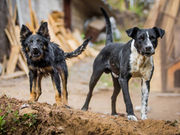LN34 is highly accurate and produces results more quickly and cost-effectively than current methods
WEDNESDAY, May 16, 2018 (HealthDay News) — A new rapid rabies test for animals could revolutionize screening and spare humans unnecessary painful treatment, according to a U.S. Centers for Disease Control and Prevention study published online May 16 in PLOS ONE.
The CDC-developed test — called LN34 — is highly accurate and produces results more quickly and cost-effectively than current methods, according to the agency. The test, done on suspect animals, can be run on platforms already widely used to screen for the flu, tuberculosis, and HIV. By contrast, the current screening mechanism — the direct fluorescent antibody (DFA) test — requires expensive microscopic instruments and highly skilled technicians. Both are often in short supply in those parts of the world where rabies risk is a serious concern (i.e., Africa and Asia).
Another advantage of the LN34 test: it doesn’t require complex training. And it can produce reliable results whether the animal tissue probed is fresh, frozen, or decomposed, the researchers said. The DFA test only works with fresh tissue that’s kept cold, a tall order in places where electricity is not always available. To date, 3,000 animal brain samples from more than 60 mammal species have been tested in 14 labs across the world. The LN34 test proved nearly 100 percent accurate, producing just one false negative and 11 false positive results, according to the study.
“The LN34 test has the potential to really change the playing field,” first author Crystal Gigante, Ph.D., a microbiologist with the CDC, said in an agency news release. “Quickly knowing who needs to receive rabies treatment, and who does not, will save lives and families’ livelihoods.” With a better test, people exposed to potentially rabid animals could avoid the weeks-long series of shots now given to prevent the disease.
Copyright © 2018 HealthDay. All rights reserved.








